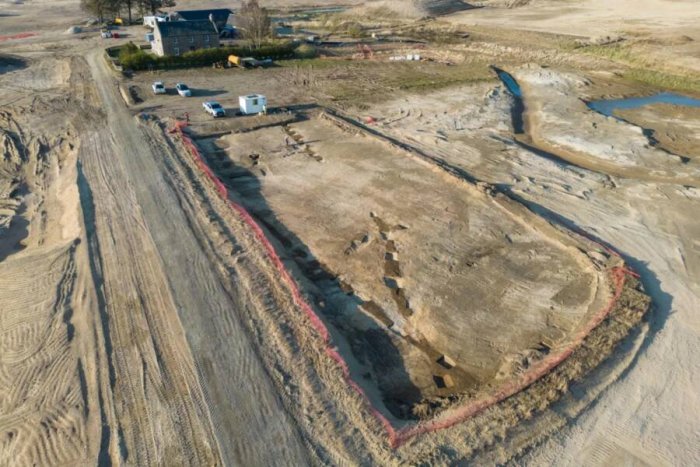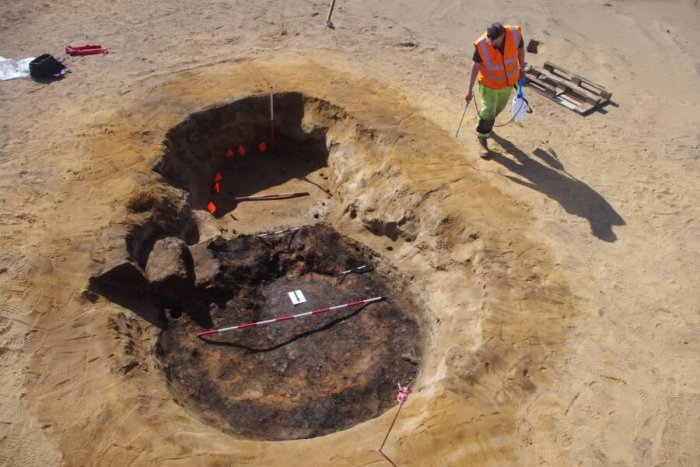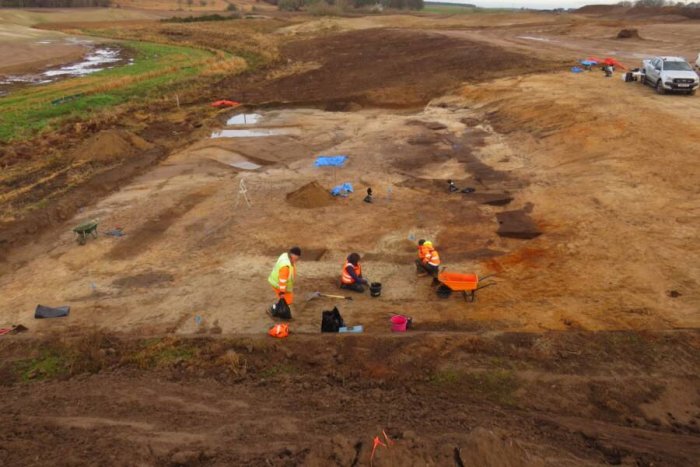Conny Waters – AncientPages.com – Recent archaeological discoveries in the Scottish Highlands have garnered significant attention due to their historical significance. Initially, there was skepticism about the importance and age of these findings, but it soon became clear that archaeologists had uncovered a rare 3,500-year-old chariot wheel. This discovery is part of a larger collection of artifacts spanning thousands of years, including a Bronze Age cremation urn.
The ancient cremation pit, where the chariot wheel was discovered, serves as a significant archaeological site. Credit: Avon Archaeology Highland
These artifacts were unearthed during excavations at the Old Petty Championship Golf Course development site near Inverness. The site has revealed an extensive historical narrative, featuring remnants from Neolithic wooden structures that offer insights into early Scottish life. Additionally, a prehistoric ceremonial circle was found, suggesting ancient rituals and beliefs.
Avon Archaeology representatives reported that the chariot was buried in a ceremonial pit alongside cremated human remains, coarse pottery, and animal bones. This combination of artifacts suggests the site served as a votive burial deposit for a wealthy individual of high status, possibly a tribal chief.
Beyond prehistoric times, evidence from the Medieval period has also been discovered. Archaeologists have identified traces of medieval field systems and grain-drying kilns, shedding light on agricultural practices from that era. The chariot wheel adds further intrigue to the site’s history by raising questions about its use and the people who utilized it.
Avon Archaeology Highland reports that these excavations have uncovered approximately 25 prehistoric buildings equipped with flint tools and quern stones. These findings provide a comprehensive understanding of ancient life in the Highlands across various eras, spanning from approximately 6,000 years ago to medieval times, encompassing both ceremonial activities and agricultural advancements.
Medieval ditches and field systems were found at the site. Credit: Avon Archaeology Highland
Stuart McColm from Cabot highlighted the significance of these discoveries for both heritage preservation and modern development: “This has been a remarkable journey from prehistoric times to the present, right here on our doorstep. It’s humbling to think that our new championship course, Old Petty, will rest on such historically rich ground. We’re proud to preserve this heritage while creating a world-class golf experience.” Measures are being taken to preserve these artifacts; notably, the ceremonial circle has been carefully reburied for protection.
An Iron Age chariot wheel was discovered in a cremation pit at the site. Credit: Avon Archaeology Highland
Andy Young from Avon Archaeology Highland expressed enthusiasm over these exceptional finds related to early Neolithic settlements and later prehistoric activities. “They are such a rare thing,” he said.
“None of us had really seen one before in terms of physically excavating one.” At first, Young assumed the wheel belonged to modern equipment, but further analysis confirmed its historic value. “I was initially a bit dismissive,” he said.
A Bronze Age urn was also found at the site. Credit: Avon Archaeology Highland
“Always happy to see new archaeology emerge from the ground, but some of the discoveries we have made, particularly relating to early Neolithic settlement and later prehistoric ceremonial/funerary activity, are properly exceptional,” Young said.
Archaeologists are excavating at the site. Credit: Avon Archaeology Highland
He emphasized that while personal heritage interests may vary regarding which finds hold the most importance, the ceremonial and funerary palisade circle containing remains, such as those found inside East Yorkshire’s chariots, stands out as particularly noteworthy.
See also: More Archaeology News
Chariot remains are relatively uncommon in Scotland, with archaeologists having identified only four vehicle components across the country. Nearly 25 years ago, a chariot was discovered buried at Newbridge in Edinburgh. In 2008, archaeologists discovered a significant clue about chariot use approximately 40 miles (64 km) away at Birnie, near Elgin, when a fragment of a horse harness was unearthed during an archaeological excavation at an Iron Age site. The latest discovery holds particular significance as it appears to be the first chariot component ever found in the Scottish Highlands.
The recent finds are to be radiocarbon dated and documented before being handed over to museums in Inverness and Edinburgh.
Written by Conny Waters – AncientPages.com Staff Writer






